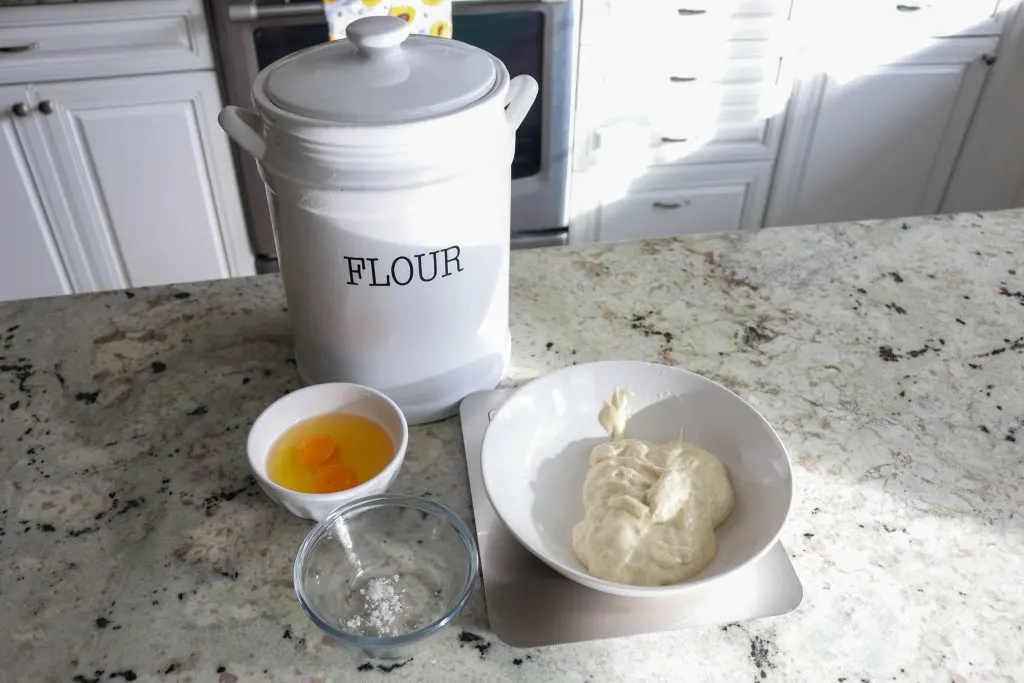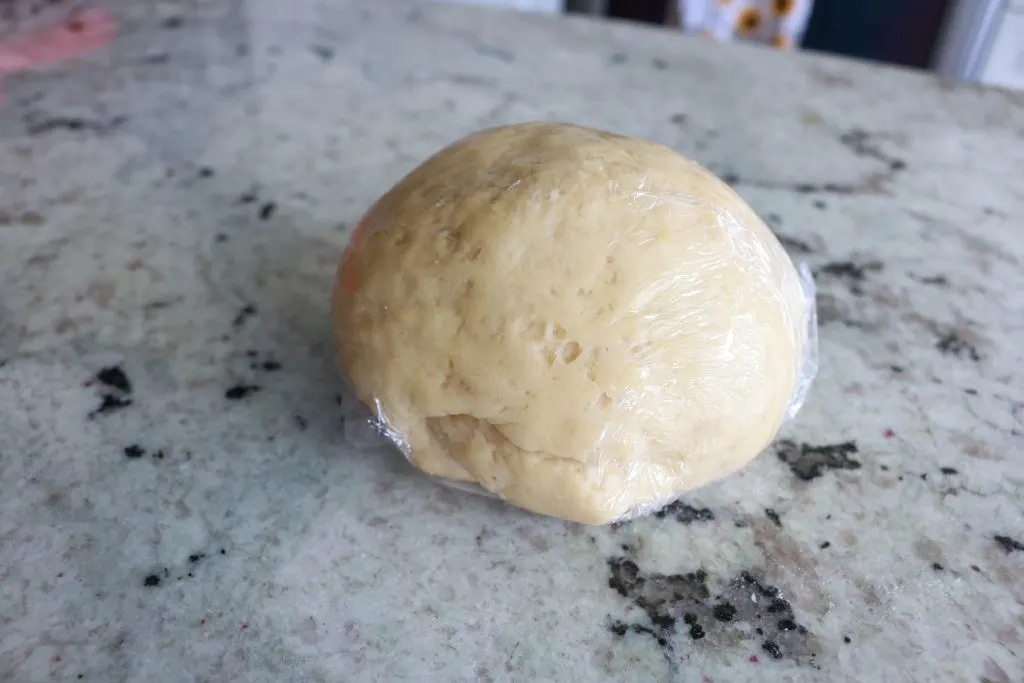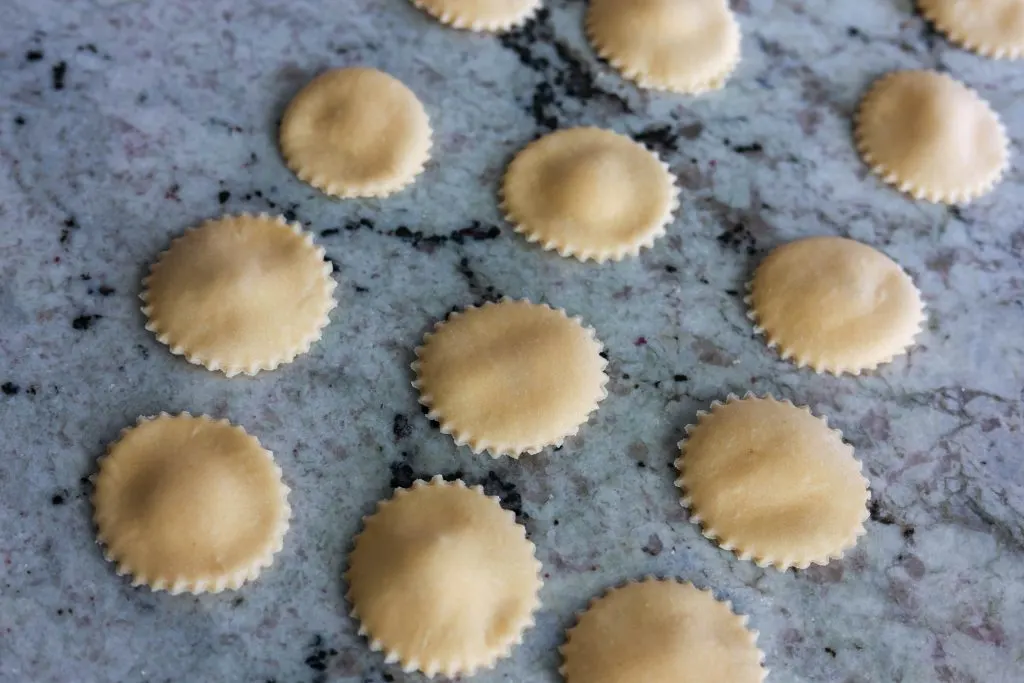Sourdough cheese ravioli is a great way to use up extra sourdough starter. This delicious ravioli has great flavor with a hint of sourdough tang.
Sourdough ravioli is easy to make. The base of the ravioli only requires a few ingredients and is simple to put together. I used a cheese filling with prosciutto in this ravioli for a delicious pop of flavor. This ravioli can be served with a sauce, or dressed in olive oil and Italian seasonings.
I’m always looking for new ways to incorporate sourdough starter or sourdough discard into recipes. I love this easy to make yummy ravioli.

If you have never made ravioli from scratch before, it can be intimidating. I have put together a few frequently asked questions and troubleshooting tips to help you succeed.
Common issues with homemade ravioli:
- Dough Issues:
- Too Sticky or Dry: Adjust the flour or liquid content. If it’s sticky, add more flour; if it’s dry, add more liquid. Gradually make adjustments until you achieve a smooth, pliable dough.
- Tears or Breaks: Knead the dough thoroughly and allow it to rest before rolling.(this dough needs to rest a minimum of 30 minutes). If it tears during rolling, patch it up with a bit of extra dough and roll that section again.
- Filling Issues:
- Leakage during Cooking: Ensure that you’re not overfilling the ravioli. Use a small amount of filling, leaving enough space around the edges to seal properly. Also, make sure the edges are well-sealed.
- Filling Too Wet: If your filling is too moist, it can lead to soggy ravioli. Try draining excess liquid from ingredients like vegetables or cheese before using them as filling.
- Sealing and Shaping:
- Edges Won’t Seal: Use a small amount of water or egg wash on the edges to help them stick together. Press firmly to seal the edges, making sure there are no air pockets.
- Shapes Falling Apart: If your ravioli are falling apart during cooking, it may be due to under-sealing. Ensure that the edges are properly sealed to prevent the filling from leaking out.
- Cooking Issues:
- Sticking Together: Make sure the water is boiling before adding the ravioli, and stir them gently at the beginning to prevent sticking. Adding a bit of oil to the water may also help.
- Overcooking/Undercooking: Follow the recommended cooking time, usually just a few minutes in boiling water. Test a sample ravioli to check for doneness. Overcooked ravioli can become mushy, while undercooked ones may be tough.
- Sauce Compatibility:
- Sauce Sliding Off: Choose a sauce with the right consistency. Creamy sauces may adhere better to the pasta, while thicker sauces can cling to the ravioli more effectively.

Sourdough Ravioli Filling Ideas:
You can use a number of different filling combinations for your ravioli. For this sourdough cheese ravioli we are using a ricotta cheese blend with romano cheese and chopped prosciutto. Here are a few more filling ideas:
1. Classic Ricotta and Spinach:
- Ricotta cheese
- Chopped cooked spinach
- Parmesan cheese
- Nutmeg
- Salt and pepper
2. Mushroom and Goat Cheese:
- Sautéed mushrooms (such as shiitake or cremini)
- Goat cheese
- Garlic
- Thyme
- Salt and pepper
3. Butternut Squash and Sage:
- Roasted and mashed butternut squash
- Ricotta cheese
- Sage, finely chopped
- Nutmeg
- Salt and pepper
4. Lobster and Mascarpone:
- Cooked lobster meat, finely chopped
- Mascarpone cheese
- Chives
- Lemon zest
- Salt and pepper
5. Three Cheese Blend:
- Ricotta cheese
- Mozzarella cheese
- Parmesan cheese
- Fresh basil
- Salt and pepper
6. Shrimp and Pesto:
- Cooked shrimp, finely chopped
- Pesto sauce
- Ricotta cheese
- Garlic
- Lemon juice
7. Sweet Potato and Sage:
- Roasted and mashed sweet potato
- Ricotta cheese
- Sage, finely chopped
- Brown butter sauce for serving
8. Spinach and Feta:
- Chopped cooked spinach
- Feta cheese
- Garlic
- Lemon zest
- Salt and pepper
9. Pumpkin and Gorgonzola:
- Roasted and mashed pumpkin
- Gorgonzola cheese
- Sage
- Nutmeg
- Salt and pepper
10. Beef and Mushroom:
- Ground beef, cooked
- Sautéed mushrooms
- Onion
- Garlic
- Parmesan cheese
Feel free to mix and match ingredients based on your preferences. You can also experiment with different herbs, spices, and cheeses to create your unique ravioli filling. Additionally, consider the type of sauce you plan to serve with the ravioli, as it can complement and enhance the flavors of the filling.

How to know when your Sourdough Cheese Ravioli is done cooking:
Knowing when ravioli is done cooking is crucial to achieving the perfect texture—firm but tender without being mushy. Here are some general guidelines to determine when your ravioli is ready:
- Floating to the Surface: Fresh ravioli often float to the surface of the boiling water when they are cooked. When they float, let them cook for an additional 1-2 minutes before testing for doneness.
- Time Recommendations: Follow the recommended cooking time provided in the recipe. Typically, fresh ravioli cooks faster than dried ones. Keep in mind that these are just guidelines, and actual cooking times can vary based on the size and thickness of the ravioli.
- Taste Test: Take out one ravioli and carefully cut it open or take a small bite. The pasta should be tender but still have a bit of firmness (al dente). The filling should be hot. If the pasta is gummy or the filling is cold, it needs more time.
- Color Change: The color of the ravioli might change slightly as they cook. They usually become more translucent, and the edges might appear softer.
- Buoyancy Test: If the ravioli feels buoyant and has a slightly puffy appearance, it’s a good indicator that they are done. However, this is not foolproof, as some well-sealed ravioli may not puff up much.
- Check a Few Pieces: If you’re cooking a batch of ravioli, check a few pieces rather than relying on just one. This ensures that you get a representative sample.
Remember, overcooking can lead to mushy ravioli, so it’s better to slightly undercook them and allow them to finish cooking in the sauce if needed. If you’re uncertain, it’s always a good idea to test one piece and adjust the cooking time accordingly.
Different types of ravioli and personal preferences can influence the cooking time, so use these methods as general guidelines and adjust based on your specific situation.
More Delicious Sourdough Recipes:



Making Sourdough Cheese Ravioli:







Sourdough Cheese Ravioli
Sourdough ravioli is easy to make. The base of the ravioli only requires a few ingredients and is simple to put together. I used a cheese filling with prosciutto in this ravioli for a delicious pop of flavor. This ravioli can be served with a sauce, or dressed in olive oil and Italian seasonings.
Ingredients
- Ravioli Dough:
- 300 g unbleached all purpose flour
- 150 g sourdough discard (or recently fed starter)
- 2 eggs
- 1/2 tsp sea salt
- Cheese Filling:
- 1 1/2 cups ricotta cheese
- 1/4 cup fresh grated romano cheese
- 4 strips prosciutto chopped fine
- 1 egg slightly beaten
- 1/4 tsp ground nutmeg
- salt and pepper to taste
Instructions
- On a clean counter, pour out 300g of flour and make a well in the center.
- Add the eggs into the well and lightly beat with a fork
- Pour the sourdough starter and sea salt on the eggs
- Start incorporating small amounts of flour from the sides of the well and gently mix into the egg mixture.
- Slowly mix the flour into the wet ingredients until a rough dough forms.
- Gently start to knead the dough until it is formed into a smooth ball.
- Cover in plastic wrap and rest on the counter for at least 30 minutes.
- Divide the dough ball into two equal parts and set one aside.
- Roll the dough out on the clean counter. (If your dough is slightly sticky, you can lightly flour the countertop.)
- Continue rolling the dough into a large rectangle until your dough is very thin and pliable.
- Dough should be very thin and almost transluscent
- Make the filling by adding ricotta, romano cheese, prosciutto, egg, ground nutmeg, salt and pepper into a medium bowl
- Mix well until creamy consistency.
- Spoon a drop of filling evenly across the ravioli dough. Make sure you are leaving enough space between the filling dollops to seal the edge of the dough.
- Carefully lift the second rectangle of rolled dough off the counter and lay gently across the dollops of filling.
- Use a ravioli cutter, or pizza cutter to to cut ravioli into shapes. Make sure the edges of the dough are sealing. If edges are not sealing, add a small amount of water to the edge and press closed.
- Bring a large pot of water to a rolling boil and add a pinch of salt.
- Gently add ravioli to the boiling pot of water.
- Cook in water for 5-6 minutes until ravioli is floating and cooked through.
- Remove ravioli and add sauce or ravioli seasonings
- I like to serve mine with olive oil, Italian seasonings, and some romano cheese on top.
- Serve immediately and enjoy!
Notes
These ravioli are delicious with olive oil and seasonings, or served with a marinara sauce.
Follow Us:
We enjoy meeting you on our social networks. Follow us on Facebook, Pinterest, Instagram . Tag us with your pictures of our recipes and comment on how it went for you. We would love to see what you do with them.
We often like, comment and share your posts of our recipes on our daily Instagram stories.
Ask questions and rate the recipe in the comments section below. Please share what you did with this recipe. We are always looking for more and better ways to make homemade food. Other cooks love your ideas!
Recent Posts:

